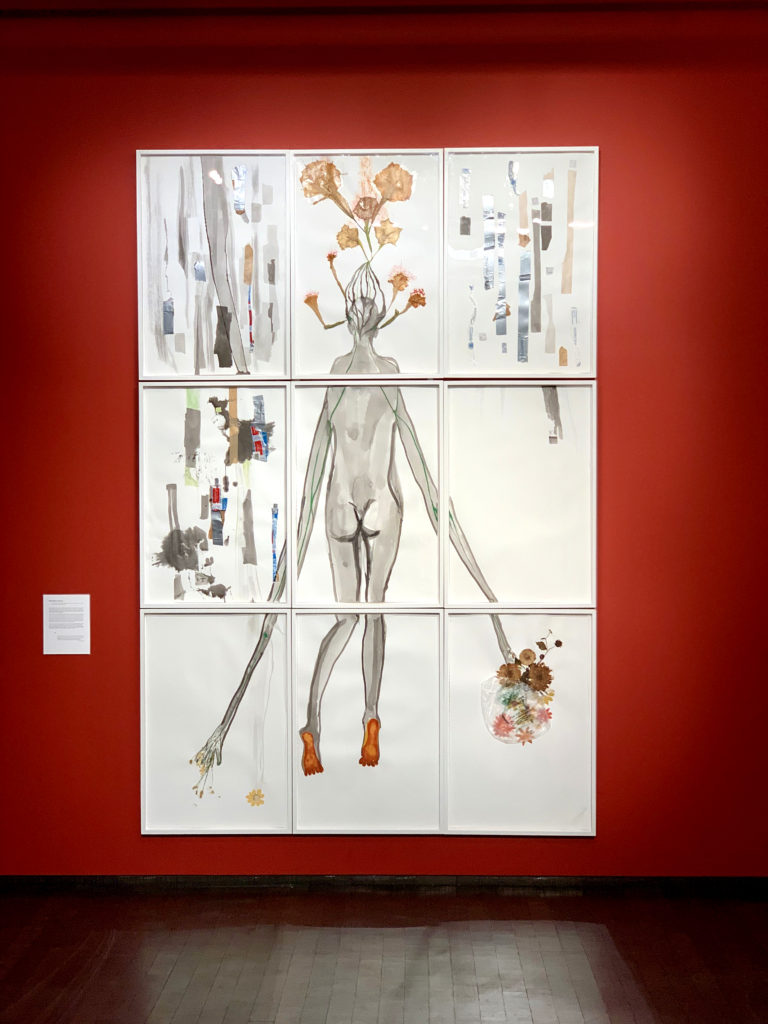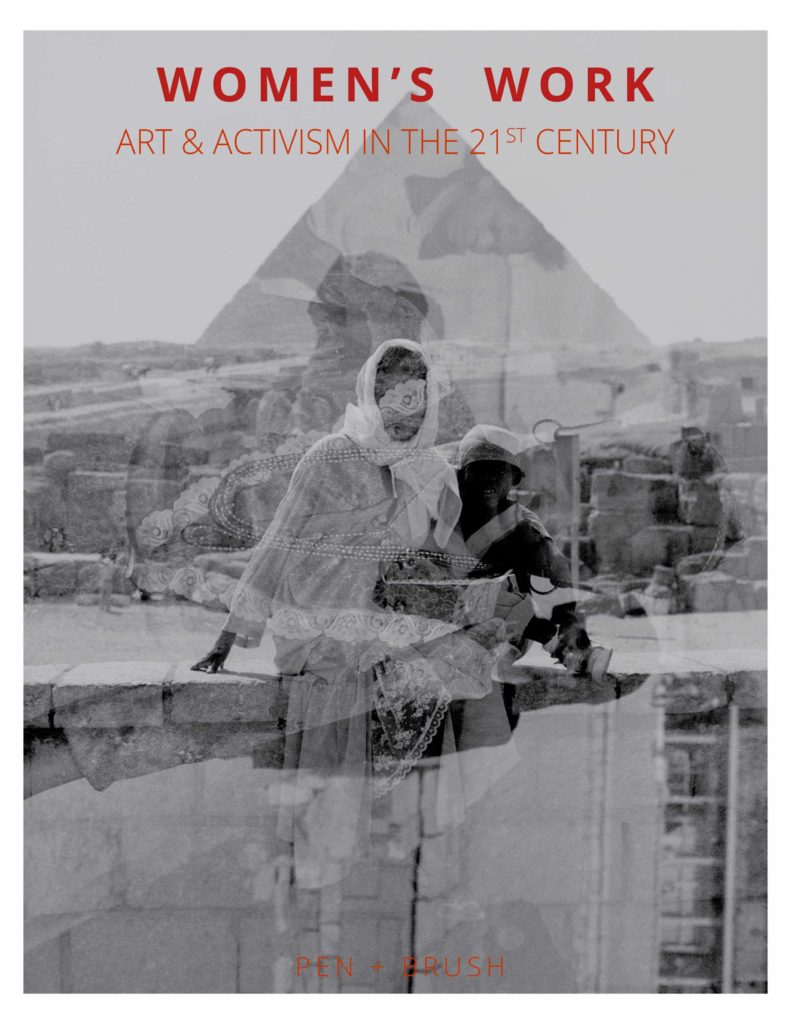María Magdalena Campos-Pons: Entangled Genealogies of Women’s Work
Installation shot of Angel’s Trumpets, Devil’s Bells, 2019. Mixed media on Arches archival paper, 9 panels, video. © María Magdalena Campos-Pons. Courtesy of the artist. Photo: Parker Daley.
While it would be predictable to misinterpret the floral mapping on a woman’s body as essentializing femininity, for Campos-Pons, the campana refers to entangled female genealogies and labors in the African and Cuban diasporas.
BY TAO LEIGH GOFFE | SPRING/SUMMER 2019
The Women’s Work Issue coincides with the Women’s Work: Art & Activism in the 21st Century exhibition at Pen and Brush in New York City. On view April 10 – August 2, 2019.
Cuban-born artist María Magdalena Campos-Pons’s oeuvre spans form and media, from sculpture, to photography, to painting, to video, to audio, to collage, to performance. Her work has been featured in high-profile shows, international biennials, and smaller stand-alone, site-specific exhibitions.
In each work of art, Campos-Pons beckons the audience to experience her personal history, the history of Cuba, and the trauma and resilience of African enslavement and Chinese indenture, which are both part of her ancestry. Campos-Pons’s prolific artistic production, which began in the 1980s, continues to engage with memory and materiality, the feminine and the resilient.
In many ways, the nine panels of Angel’s Trumpets, Devil’s Bells narrate a story of gestures to different preoccupations within her career. The large-scale installation is at once a look forward and a look backward for Campos-Pons. At first glance, the layered mixed-media collages seem to break from the artist’s more recent photographic self-portraiture. Yet, it is a retrospective in the way it cites former artistic focuses on women, sexuality, and an unapologetic feminist practice.
The spiritual and the ritual are central to Campos-Pons’s work. Such is the significance of including in Angel’s Trumpets, Devil’s Bells the campana, a flower that can only be found in Cuba. Possibly a natural hybrid between D.candida and D. suaveolens, the leaf and the flower are known for their medicinal and purifying properties in Afro-Cuban horticultural knowledge and herbalism.
Flowers are a recurring theme in Campos-Pons’s work. While it would be predictable to misinterpret the floral mapping on a woman’s body as essentializing femininity, for Campos-Pons, the campana refers to entangled female genealogies and labors in the African and Cuban diasporas.
Such entanglements include the blending of cosmologies indigenous to Cuba. If the archetypal pillars of womanhood offered in Roman Catholicism are the Virgin Mother, the artist’s namesake Mary Magdalene—the redeemed prostitute (sex worker), and Eve (responsible for Original Sin)—then in the tradition of Santería and other Afro-Cuban religions, Campos-Pons offers Yemaya, the mother of all orishas and the embodiment of the seas and maternity, often figured in blue.
This orisha’s presence recurs in Angel’s Trumpets, Devil’s Bells through the campana, used as part of orisha worship and rituals. The desiccated and delicate flowers sprout from the head of a black woman and are flattened and preserved on Arches archival paper. Through this figure, we see Campos-Pons’s tangled genealogy between women—sisters, mothers, grandmothers—as umbilical. It is a tangle of braids, of dreadlocks, of threads, and strands knotted, all recurring motifs.
In her naming of the work, the artist employs the dual language of “Angel’s Trumpets” for which it’s known in Cuba, and also labels them as “Devil’s Bells.” Framing the flower as having the power for good or for evil is a matter of orientation and intent for Campos-Pons who hears the music of both instruments. Indeed, the campana conjures a childhood of contradictions for Campos-Pons. Her father was a farmer for most of his life and would collect herbs from the El Monte forest, signifying the centrality of Yoruba cosmologies for the Campos-Pons family even though these rites were not always publicly acknowledged.
Though she and her parents were not initiated into Santería, one of Campos-Pons’s grandmothers, who she never met, had been a priestess. One of her great grandmothers migrated from Canton, China to Cuba and labored in sugar mills. Campos-Pons also discovered her childhood home in Matanzas was the former sugar plantation barracks that housed enslaved people, including one of her great grandfathers.
Campos-Pons came of age in Communist Cuba when religion was strictly prohibited though practiced behind closed doors. Race equality was declared by the Cuban state and yet African heritage and cultural practice was clearly denigrated and devalued.
The nine panels of Angel’s Trumpets, Devil’s Bells are a familiar geometry or grid-like ordering of space in Campos-Pons’s work, signifying separation, segmentation, exile, and cohesion as the poetics of the diasporic condition. One panel features shredded pieces of United States’ Transportation Security Administration (TSA) tape. The government is torn. But it is also salvaged, displayed, and archived.
These objects that symbolize the crossing of borders reflect another recurring theme in Campos-Pons’s work—that of longing, of waiting, of the liminal space of migration. She often speaks of her own migration experience of disruption and the impact of embargos in spaces such as airports. In tandem, the border emerges as a space of red tape, bureaucracy, biometrics surveillance, and rupture.
Yet it is also a space of becoming—emergency and emergence—for the artist who just last year was naturalized as a U.S. citizen.
♦
Tao Leigh Goffe is an Assistant Professor of Africana Studies and Feminist, Gender, and Sexuality Studies at Cornell University. She teaches courses on vernaculars that emerge from histories of imperialism, migration, and globalization. Her research examines visual, sonic, sensory, and ghost cultures across the Americas.
OF NOTE Magazine is free to readers, free of advertising, and free of subscriptions—all made possible by generous supporters like you. Your tax-deductible gift will help us continue to feature innovative and emerging global artists using the arts as tools for social change.
OF NOTE Magazine is a fiscally sponsored organization of the New York Foundation for the Arts, a 501 (c) (3), tax-exempt organization. All donations are 100% tax-deductible to the full extent of the law.




